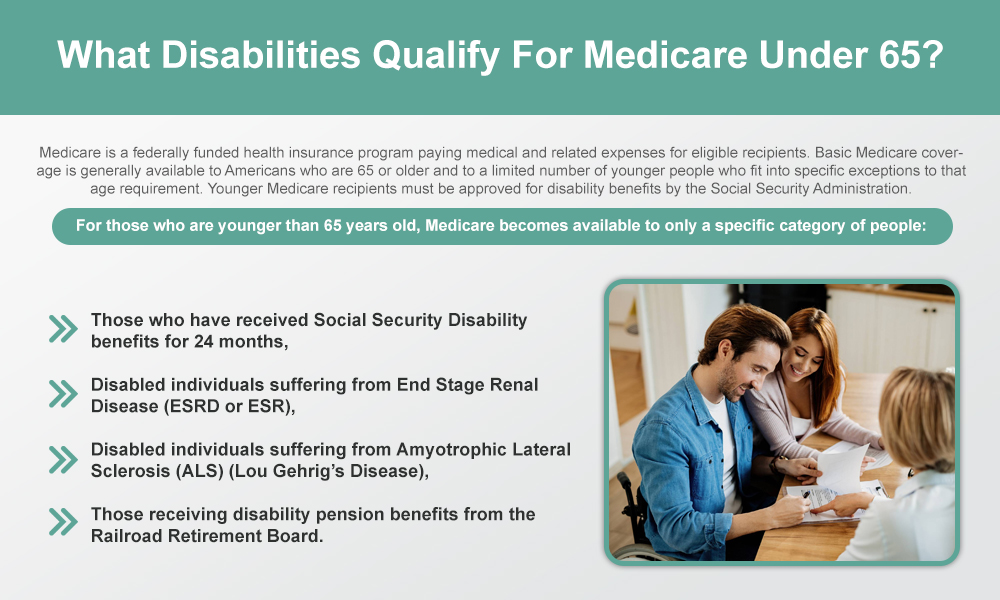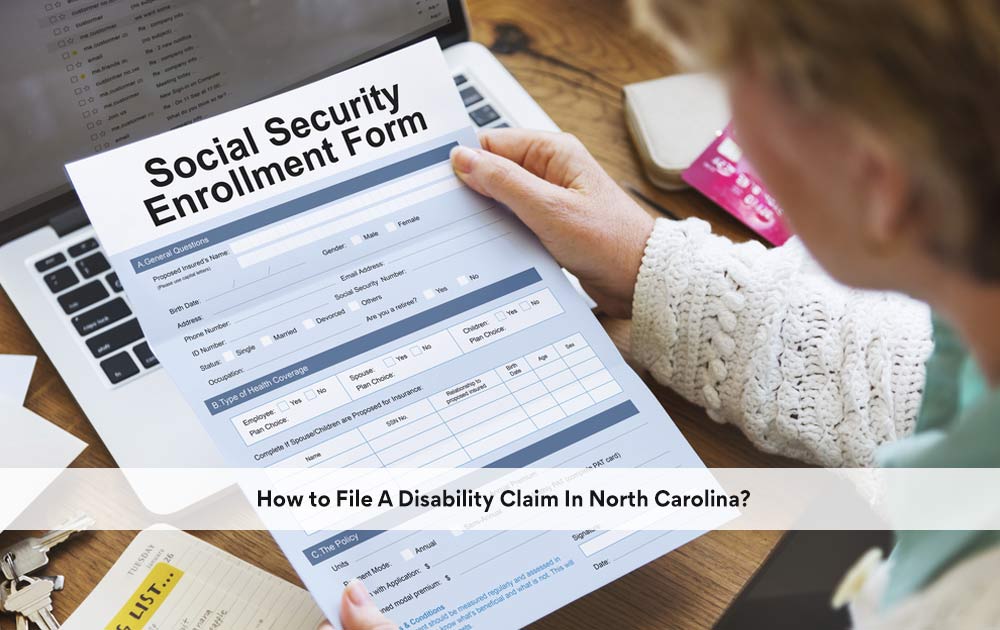Medicare is a federally funded health insurance program paying medical and related expenses for eligible recipients. Basic Medicare coverage is generally available to Americans who are 65 or older and to a limited number of younger people who fit into specific exceptions to that age requirement. Younger Medicare recipients must be approved for disability benefits by the Social Security Administration.

For those who are younger than 65 years old, Medicare becomes available to only a specific category of people:
- Those who have received Social Security Disability benefits for 24 months,
- Disabled individuals suffering from End Stage Renal Disease (ESRD or ESR),
- Disabled individuals suffering from Amyotrophic Lateral Sclerosis (ALS) (Lou Gehrig’s Disease),
- Those receiving disability pension benefits from the Railroad Retirement Board.
Eligibility also depends on whether the Medicare applicant or their spouse has accumulated enough “work credits” to qualify for cost-free coverage. Every recipient of Social Security Disability benefits must first establish that they or their spouse has earned these work credits. (Read the section below addressing the costs of Medicare for people who do not have sufficient work credits from their years of employment.)
Qualifying Disabilities for Medicare Under 65
The law provides for Medicare to be provided to those suffering from ESR and ALS at an accelerated pace because of the severe and progressive nature of each of these disabling illnesses.
In addition, anyone receiving Social Security Disability Insurance benefits for 24 months becomes eligible for Medicare. That means that any disability approved by the Social Security Administration for SSDI benefits is qualified for Medicare.
Early Medicare Eligibility for Special Qualifying Disabilities:
Both End Stage Renal Disease (ESRD) and ALS must still meet minimal eligibility criteria to satisfy Medicare eligibility requirements.
- Home Dialysis: ESRD Medicare coverage begins on the first day of the first month in which home-based dialysis commenced.
- Inpatient or Clinic-based Dialysis: For those receiving dialysis treatment outside the home in a clinical setting, Medicare coverage begins on the first day of the fourth month in which they receive dialysis.
- Kidney Transplants: If a Medicare applicant is scheduled to receive a kidney transplant, their coverage begins the month they are admitted to a Medicare-approved hospital for the transplant or for necessary pretransplant-related services.
- Amyotrophic Lateral Sclerosis (ALS) (Lou Gehrig’s Disease): For people with ALS, Medicare coverage is available the month they receive their first SSD benefit payment. Remember, though, that there is a five-month waiting period from the Social Security Administration’s assigned “disability onset date” until the first SSD benefit payment is received.
24-Month Waiting Period for Other Social Security Disability Recipients
For those younger than 65 years old whose disabling impairment is something other than ALS or ESRD, the waiting period for Medicare coverage is 24 months from the receipt of the person’s first SSD benefit payment. That means 29 months from the date of disability onset.
Advocates for disabled Americans have been lobbying Congress for years to convince them to reduce the 24-month Medicare waiting period for SSD benefits recipients. The resistance to reducing the waiting period is based on the fear that permitting disability benefits recipients earlier access to Medicare will threaten the solvency of the Medicare program.
Alternative sources of medical insurance for disabled people are often unaffordable. For those who had health insurance through their employer before becoming disabled, COBRA is available for 18 months. But the premium to maintain insurance through COBRA is 102% of the policy premium. Such a high cost is very difficult for people depending on Social Security Disability benefits as their sole source of income.
What Are Medicare Parts A, B, C, and D
When discussing Medicare, it’s important to distinguish between the different parts of Medicare, each of which provides different coverage.
Original Medicare includes Medicare Part A and B. Additional Medicare Parts C and D are options available by contracting through private insurers who bundle both original Medicare parts with Part C, often called Medicare Advantage. While Part C plans are available for many people without premiums, there are significant differences between the competing Plan C providers. Different providers offer plans with higher or lower annual deductibles, different copay rates, and different combinations of additional coverages for vision, dental, and hearing benefits.
Medicare Part A
Medicare Part A is part of what is called original Medicare. It covers in-patient hospital costs, skilled nursing care, hospice care, home health care, and nursing home care, except for custodial or long-term care. Some long-term care may be covered if the patient needs medical care.
Medicare Part B
Medicare Part B covers medically necessary services and supplies needed to diagnose or treat your medical conditions and preventative services. These services and supplies include but are not limited to clinical research, office visits, ambulance costs, and durable medical equipment (DME) like walkers, wheelchairs, traction equipment, etc.
Medicare Part B also provides coverage for inpatient and outpatient mental health treatment and some medications.
Medicare Part C
Part C plans provided by private insurers combine Parts A and B from original Medicare and usually offer additional vision, dental, and hearing benefits. However, these plans are priced at various levels based on the extent of the coverage and the cost of deductibles and copays that apply.
Some of the private plan providers offer health maintenance organization (HMO) contracts, while others offer preferred provider organization (PPO) plans. HMOs are usually less expensive than PPOs because the HMOs limit coverage to in-network healthcare providers. PPO plans are more flexible in that they permit patients to seek treatment from out-of-network providers. Flexibility comes at a cost.
Medicare Part D
Medicare Part D is a plan that covers drug costs and will require some premium payments. Part D plans also vary in costs, copays, and coverages for brand-name pharmaceuticals as opposed to generic drugs.
Paying for Medicare Coverage
What if neither you nor your spouse has enough work credits to be eligible for either Social Security Disability Insurance benefits or Medicare? SSD benefits are paid for by workers’ contributions through payroll deductions or self-employment taxes. That’s why the benefits are limited to workers and former workers whose work history has spanned at least 10 years.
A disabled person with a low income and very limited financial resources may be eligible for Supplemental Security Income (SSI). Medicaid immediately covers anyone receiving SSI benefits.
If your income or financial resources are too high to qualify for SSI or Medicaid, you can purchase Medicare coverage.
In 2023, someone who has more than 30 work credits but not enough to meet Medicare’s eligibility threshold can purchase Medicare Part A (hospital insurance) for $278 per month. If you or your spouse have fewer than 30 work credits, Medicare A can be obtained by paying $506 each month.
Premium-Free Medicare for Social Security Disability Impairments
For most Social Security Disability benefits recipients, the impairment they suffer from will fall under the more conventional procedure of qualifying for Medicare after 24 months. Whether your impairment qualifies for Social Security Disability benefits at all will depend entirely on the determination made by the Social Security Administration.
For both the Social Security Disability Insurance (SSDI or SSD) and the Supplemental Security Income (SSI) programs, the government uses the same criteria to determine if a claimed impairment qualifies for disability benefits.
The Government Defines A Qualifying Disability As Follows:
A disability is a medically determinable physical or mental impairment that last or is expected to last 12 months (or results in death) and prevents the person from performing substantial gainful activities.
This strict definition is the basis for all disability determinations in either federal SSD or SSI programs.
The first essential element emphasizes the importance of “medical determinability,” meaning the claimed disabling impairment must be confirmed by the medical records, notes, observations, and reports provided by your authoritative healthcare providers. Not only must the claimant’s symptoms be reported in clear and consistent terms, but the impairment must also be severe enough to prevent the claimant from earning sufficient income as measured by the Social Security Administration.
The Social Security Administration’s definition of a disability requires that the claimant must be unable to perform “substantial gainful activities” (SGAs). In 2023, substantial gainful activities are any activity through which a person can earn more than $1,470 per month. (Blind claimants may earn up to $2,460.)
Get Experienced Medicare Guidance from Skilled Medicare and Disability Lawyers
At the Clausen Law Office, every client gets reliable counsel from skilled disability and Medicare lawyers whose tenacious representation has resulted in thousands of successful Social Security claims and Medicare applications.
The Clausen Law firm has been providing top-tier legal representation and advocacy to disability clients for more than 45 years, making him one of the most respected and successful Social Security Disability and Medicare/Medicaid attorneys in the country. Get the information you and your family need today.


